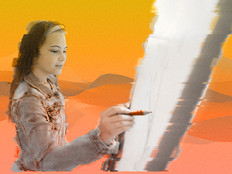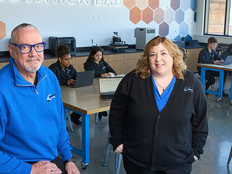Bedrock Learning
Students identify soil and rocks by using a document camera.
Urban high school students are often preoccupied by the visible science they find at eye level and fail to make the connection to the importance of the geological structures on which they live. At Hebron High School in Carrollton, Texas, students use document cameras, the Internet and computers to identify and map these structures.
Lesson description: Students learn to identify the types of soil and rocks in their area by bringing samples from home. Identification is made with the assistance of the document camera, and collaboration is encouraged. Still images of each sample are captured and saved on the computer for student presentations. If tests are necessary for soil or rock identification, students use the document camera to capture video of the test being performed. After proper identification is made and digital media is created and saved, students prepare Windows Movie Maker presentations to discuss their findings. Class collaboration follows, with each student contributing their best photos to create a wall-sized map of the area and the types of rocks and soil found in the Dallas–Fort Worth metropolis. Unusual findings or “out of place” samples are also identified and their origins noted on a world map. Students are encouraged to analyze their results, giving possible explanations for unusual findings.
Subject area: This lesson was designed for 10th- through 12th-grade students in geology, meteorology and oceanography classes. It is also appropriate for an environmental systems class, primarily delivered to 12th-grade students.
Curriculum standards: This lesson addresses the following ISTE Educational Technology Standards for Students:
- #2: Students use digital media and environments to communicate and work collaboratively, including at a distance, to support individual learning and contribute to the learning of others.
- #4: Students demonstrate creative thinking, construct knowledge and develop innovative products and processes using technology.
Resources: Students need access to a document camera, a classroom projector, computers with Windows Movie Maker, standard geological identification supplies and mapping supplies. Students can also use headphones, microphones, Internet access and a color printer.
The following websites are also helpful:
- A Tapestry of Time and Terrain: tapestry.usgs.gov/states/ texas.html
- Dallas Gem and Mineral Society: www.dallasgemandmineral.org/links_of_interest.html
- The Dallas Paleontological Society: http://www.dallaspaleo.org/
- Windows Movie Maker: www.microsoft.com/windowsxp/using/moviemaker/getstarted/default.mspx
- NGO Map Machine: ngm.nationalgeographic.com/map-machine
- Rock Identification, Introduction: http://www.classzone.com/books/earth_science/terc/content/investigations/es0610/es0610page01.cfm
Grading Rubric: Students are graded based on the proper identification of at least two rock samples and two soil samples, worth 40 points. Media presentations are worth 40 points and the final map is worth 20 points. Student participation is evident based on individual presentations and contributions to the final map.
Teaching Tips
- Students are expected to be familiar with Windows Movie Maker and the transfer of digital media from one computer to another via the network.
- Encouraging students to explore the web for more information and identification procedures can result in greater creativity and a deeper understanding of the content.







